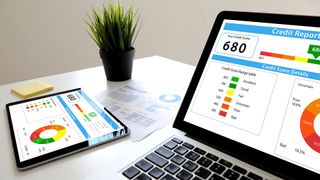Despite record low interest rates, many potential home buyers have been left frustrated in their pursuit of cheaper loans after the best mortgage lenders (opens in new tab) tightened their lending criteria in response to soaring unemployment rates and the wider economic risks caused by the COVID-19 outbreak. Even those already on the property ladder, but looking to save money via a new loan (opens in new tab) from the best refinance mortgage companies (opens in new tab), have found the credit lending tap has been turned down (opens in new tab) for all but the most qualified borrowers. Many of those seeking out the best personal loans (opens in new tab) and credit cards (opens in new tab) will have faced a tougher battle in their dealings with providers too.
What is the FICO Resilience Index?
Now, however, the situation could be about to change, after FICO - the company that produces the widely-used FICO Score credit scoring system - unveiled a new index (opens in new tab) intended to help lenders better evaluate the capacity of borrowers to withstand an economic downturn, such as now. Designed to be used alongside the regular FICO Score, the FICO Resilience Index will allow mortgage lenders and loan companies to identify borrowers that are resilient to economic stress and should not be subject to more stringent criteria, including those with lower credit scores. “Lenders and investors need to be able to evaluate and manage portfolios based on rapidly changing conditions, to further safety and soundness in credit as well as support the global economy,” said Sally Taylor, vice president and general manager, FICO Scores. “Consumers benefit when lenders have the tools to identify resilient borrowers, enabling lenders to price their products more competitively and to responsibly provide greater access to credit than they would otherwise be able to do.”
How does the resilience index work?
The score has been introduced following analysis of more than 70 million consumer credit files during the Great Recession of 2007 to 2009. According to FICO, most consumers, including those with lower credit scores, continued to pay their credit obligations and responsibly managed their financial affairs, despite the backdrop of double-digit unemployment and low consumer confidence. The analysis (opens in new tab) also revealed that higher-resilience consumers tend to have more experience managing credit, lower total revolving balances, fewer active accounts, and fewer credit inquiries in the last year. While the FICO Score ranges from an “exceptional” 850 to a “very poor” 300, the FICO Resilience Index uses a scale from 1-99, with those in the range of 1 to 44 regarded as the most prepared and able to weather an economic shift.
How could the resilience index benefit you?
The hope is that loan companies will use the new information to better-inform their lending judgements, and realize that they do not necessarily have to cut off, curtail or raise the cost of credit access for all borrowers during a downturn. Analysis by Tom Parrent, principal at the financial services analytics company Quantilytic (opens in new tab), suggests that from 2010 to 2015, an additional 600,000 mortgages could have been originated to consumers with FICO Scores between 680 and 699 had the FICO Resilience Index been available to lenders at the time. “Through more precise credit analytics, lenders concerned about increased economic stress can maintain lending to more consumers, while still protecting their portfolio,” says Parrent. “Broader lending to more resilient borrowers may even soften the impact of a downturn should it occur.”
How else can you improve your credit score?
With the FICO Resilience Index only just available for lenders to pilot, it may take a little while longer for the potential benefits to feed through to borrowers. In the meantime, the challenges facing those trying to secure credit - whether it be a mortgage, personal loan, credit card, or the best auto loans (opens in new tab) - are likely to continue. On a general level, if you’ve recently been turned down for a loan because of your credit score, there are several steps (opens in new tab) you can take to try and improve it. Paying bills on time will help, while if you’re struggling financially, making at least the minimum payment by any due date is also advisable, both to make sure you don’t fall behind with your debt and to avoid negative marks on your credit report. Paying off debt will almost always help boost your credit rating, and be viewed favorably by lenders assessing whether they want you as a customer. For this reason, anyone whose credit score is being dragged down by debt might need to consider the best debt consolidation companies (opens in new tab) to get themselves back on firmer financial ground. If possible, it is also best to leave at least six months between credit applications, otherwise lenders could view your financial circumstances with suspicion and maybe doubt your ability to repay your debts. If you’re not sure of your credit situation, or want to monitor how successful you have been in improving it, the best credit report services (opens in new tab) can provide you with prior insight into your credit score and reports, and will alert you when something changes on your report. If these steps still fail to improve your credit situation, it may be time to approach the best credit repair services (opens in new tab) to see if they can help restore your credit report to better health. By removing errors and fixing other credit report problems, credit repair companies can help improve your chances of loan success in the future.
